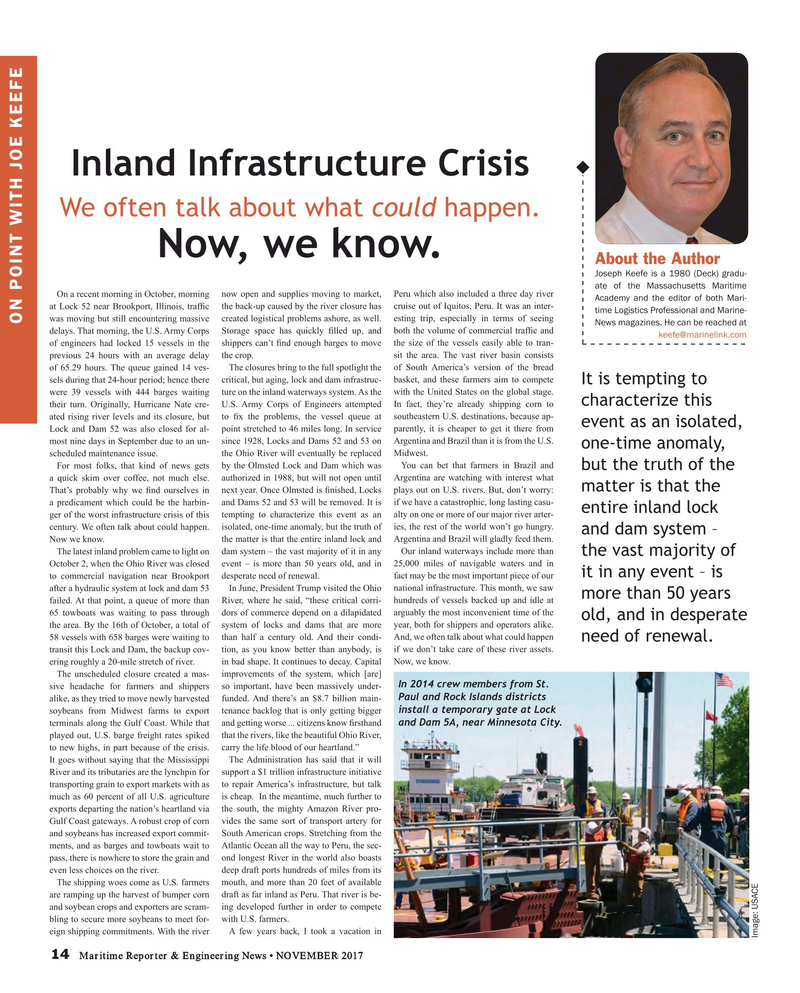
Page 14: of Maritime Reporter Magazine (November 2017)
The Workboat Edition
Read this page in Pdf, Flash or Html5 edition of November 2017 Maritime Reporter Magazine
Inland Infrastructure Crisis
We often talk about what could happen.
Now, we know.
About the Author
Joseph Keefe is a 1980 (Deck) gradu- ate of the Massachusetts Maritime
On a recent morning in October, morning now open and supplies moving to market, Peru which also included a three day river
Academy and the editor of both Mari- at Lock 52 near Brookport, Illinois, traf? c the back-up caused by the river closure has cruise out of Iquitos, Peru. It was an inter- time Logistics Professional and Marine- was moving but still encountering massive created logistical problems ashore, as well. esting trip, especially in terms of seeing
News magazines. He can be reached at ON POINT WITH JOE KEEFE delays. That morning, the U.S. Army Corps Storage space has quickly ? lled up, and both the volume of commercial traf? c and [email protected] of engineers had locked 15 vessels in the shippers can’t ? nd enough barges to move the size of the vessels easily able to tran- previous 24 hours with an average delay the crop. sit the area. The vast river basin consists of 65.29 hours. The queue gained 14 ves- The closures bring to the full spotlight the of South America’s version of the bread sels during that 24-hour period; hence there critical, but aging, lock and dam infrastruc- basket, and these farmers aim to compete
It is tempting to were 39 vessels with 444 barges waiting ture on the inland waterways system. As the with the United States on the global stage. characterize this their turn. Originally, Hurricane Nate cre- U.S. Army Corps of Engineers attempted In fact, they’re already shipping corn to ated rising river levels and its closure, but to ? x the problems, the vessel queue at southeastern U.S. destinations, because ap- event as an isolated,
Lock and Dam 52 was also closed for al- point stretched to 46 miles long. In service parently, it is cheaper to get it there from most nine days in September due to an un- since 1928, Locks and Dams 52 and 53 on Argentina and Brazil than it is from the U.S. one-time anomaly, scheduled maintenance issue. the Ohio River will eventually be replaced Midwest.
For most folks, that kind of news gets by the Olmsted Lock and Dam which was You can bet that farmers in Brazil and but the truth of the a quick skim over coffee, not much else. authorized in 1988, but will not open until Argentina are watching with interest what matter is that the
That’s probably why we ? nd ourselves in next year. Once Olmsted is ? nished, Locks plays out on U.S. rivers. But, don’t worry: a predicament which could be the harbin- and Dams 52 and 53 will be removed. It is if we have a catastrophic, long lasting casu- entire inland lock ger of the worst infrastructure crisis of this tempting to characterize this event as an alty on one or more of our major river arter- century. We often talk about could happen. isolated, one-time anomaly, but the truth of ies, the rest of the world won’t go hungry. and dam system –
Now we know. the matter is that the entire inland lock and Argentina and Brazil will gladly feed them.
The latest inland problem came to light on dam system – the vast majority of it in any Our inland waterways include more than the vast majority of
October 2, when the Ohio River was closed event – is more than 50 years old, and in 25,000 miles of navigable waters and in it in any event – is to commercial navigation near Brookport desperate need of renewal. fact may be the most important piece of our after a hydraulic system at lock and dam 53 In June, President Trump visited the Ohio national infrastructure. This month, we saw more than 50 years failed. At that point, a queue of more than River, where he said, “these critical corri- hundreds of vessels backed up and idle at 65 towboats was waiting to pass through dors of commerce depend on a dilapidated arguably the most inconvenient time of the old, and in desperate the area. By the 16th of October, a total of system of locks and dams that are more year, both for shippers and operators alike. 58 vessels with 658 barges were waiting to than half a century old. And their condi- And, we often talk about what could happen need of renewal. transit this Lock and Dam, the backup cov- tion, as you know better than anybody, is if we don’t take care of these river assets. ering roughly a 20-mile stretch of river. in bad shape. It continues to decay. Capital Now, we know.
The unscheduled closure created a mas- improvements of the system, which [are]
In 2014 crew members from St. sive headache for farmers and shippers so important, have been massively under-
Paul and Rock Islands districts alike, as they tried to move newly harvested funded. And there’s an $8.7 billion main- install a temporary gate at Lock soybeans from Midwest farms to export tenance backlog that is only getting bigger and Dam 5A, near Minnesota City.
terminals along the Gulf Coast. While that and getting worse ... citizens know ? rsthand played out, U.S. barge freight rates spiked that the rivers, like the beautiful Ohio River, to new highs, in part because of the crisis. carry the life blood of our heartland.”
It goes without saying that the Mississippi The Administration has said that it will
River and its tributaries are the lynchpin for support a $1 trillion infrastructure initiative transporting grain to export markets with as to repair America’s infrastructure, but talk much as 60 percent of all U.S. agriculture is cheap. In the meantime, much further to exports departing the nation’s heartland via the south, the mighty Amazon River pro-
Gulf Coast gateways. A robust crop of corn vides the same sort of transport artery for and soybeans has increased export commit- South American crops. Stretching from the ments, and as barges and towboats wait to Atlantic Ocean all the way to Peru, the sec- pass, there is nowhere to store the grain and ond longest River in the world also boasts even less choices on the river. deep draft ports hundreds of miles from its
The shipping woes come as U.S. farmers mouth, and more than 20 feet of available are ramping up the harvest of bumper corn draft as far inland as Peru. That river is be- and soybean crops and exporters are scram- ing developed further in order to compete bling to secure more soybeans to meet for- with U.S. farmers. eign shipping commitments. With the river A few years back, I took a vacation in
Image: USACE 14 Maritime Reporter & Engineering News • NOVEMBER 2017
MR #11 (10-17).indd 14 MR #11 (10-17).indd 14 11/5/2017 12:46:09 PM11/5/2017 12:46:09 PM

 13
13

 15
15
